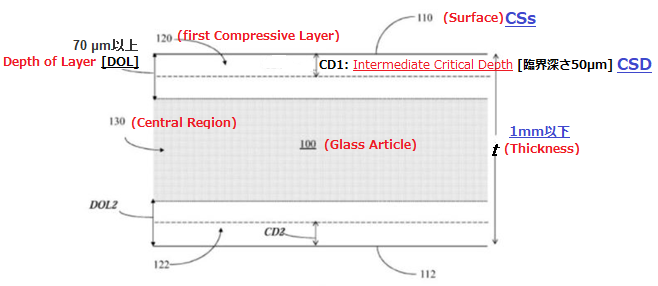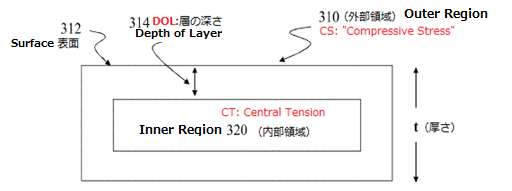
|
PTAB�R�� Ex
Parte Morey 2020�N7��2�� https://e-foia.uspto.gov/Foia/RetrievePdf?system=BPAI&flNm=fd2018005633-07-02-2020-0 Result-Effective
Variable (���ʂ�̂ɗL���ȕϐ�)�̍œK���Ƃ���103������� ����R���i�o��l�ɂƂ��ėL���Ȕ��_�́H�j Summarized
by Tatsuo YABE – 2020-09-30 |
|
�{�����PTAB�ɂ��R���ł��莩��������Ɋւ���B���ɍޗ��n�̏o��ɂ����āi���J�ł��Ƃ��ǂ��j�ϐ�������͈͂ɋK�肷��N���[����Result-Effective-Variable�i���ʂ邽�߂ɗL���ȕϐ��j�ł��蓖�Ǝ҂ɂƂ��ē��Y�ϐ����œK�����邱�Ƃ͎����ł���Ƃ���������邱�Ƃ�����܂��B���̎�̋�������Ƃ��ɂ͔�r�I�ŋ߉������ꂽ�R���֗�2144�Ɋ�Â��Ή����邱�Ƃ��]�܂����B�����A�R������Result-Effective-Variable�Ƃ���ϐ�����s�Z�p�ɂ����ď��]���錋�ʂ邽�߂ɉe����^����i�L���ȁj�ϐ��ł��邱�Ƃ��F������Ă��Ȃ����Ƃ��ؖ������_����B
|
�{����i�R���j�ł̓X�}�z���Ɏg�������1�o�ȉ��̋����K���X�Ɋւ�锭���Ɋւ��A���Y�K���X�̏���[���̈��k���͂�\�ʂ̈��k���͂ɑ�������䗦�ɂ��邱�Ƃ��K�肳��Ă����B�ł��֘A���̂����s�Z�p�ɂ����ĕ\�ʗ̈�Ɠ����̈������[���A�y�сA���ꂼ��̈��k���͂��J������Ă��������ƂȂ����N���[���ŋK�肷�鈳�k���͂ɑ����䗦���j�f�ϐ��ɑ���L���ȕϐ��ł��邱�Ƃ͔F������Ă��Ȃ��Ƃ��ċ��⍸�肪�s���Ɣ��f���ꂽ�B�i�ȏ�M�ҁj
Online Seminar �@(���ӁFClick���Ď����ł��Ȃ��ꍇ�ɂ�URL���R�s�[��������������): https://www.youtube.com/watch?v=hWYk4bGmOlg
|
��������������������������������������������������������������������
���@�R�������l�FCorning
Incorporated (Laurence Ralph Morey: Inventor)
���@�֘A�����o��FUS
Patent Application No. 14/340,670
���@�����o�蔭���̊T�v�F
�g�ѓd�b�A�^�u���b�g�A���b�v�g�b�v�E�R���s���[�^�[���Ɏg�p��������1mm�ȉ��̋����K���X�Ɋւ��A���ڍׂɂ͗����Ȃǂɂ��j�f�ϐ����������邽�߂ɕ\�ʈ��k���͂ƕ\�ʂ��50�ʂ������̈��k���͂Ƃ̊W���K�肵���B
|
���@���_�F
�\�ʂɂ����鈳�k����(CSs:
Compressed Stress @Surface)�ƕ\�ʂ��50�ʂ������̈��k����(CSD:
Compressed Stress at Depth)�Ƃ��䗦(�gCSs/CSD�h)������͈́i���Ȃ��Ƃ�10���j�ɂ��邱�Ƃ��K�肷��N���[���ɂ�����Barefoot����Ɋӂ����Y�䗦�͌��ʂ邽�߂ɗL���ȕϐ��iresult
effective parameter�j�ƔF������邩�ۂ��H
|
���@���ƂȂ����N���[���F
|
|
Claim 5 of US Patent Application No.
14/340,670 |
�N���[���T |
|
5. A
strengthened glass article comprising:
a
thickness t ≤ 1 mm,
an
inner region under a central tension CT, and
at
least one compressive stress layer adjacent the inner region and extending
within the strengthened glass article from a surface of the strengthened
glass article to a depth of layer DOL,
wherein
the DOL is greater than or equal to70 ��m,
wherein
the strengthened glass article is under a compressive stress at the
surface CSs,
wherein
the strengthened glass article is an alkali aluminosilicate glass article
comprising 0 mol% Li2O, and at least 3 mol % Al2O3, and
wherein
the strengthened glass article has a stress profile such that a
compressive stress CSD at an intermediate critical depth of
50 ��m below the surface of the strengthened glass article is at least 10%
of CSs. |
�����K���X���i�ł����Ĉȉ��̍\���v�f�������F �@����1�����ȉ��G �@�������͉��ɂ�������̈�G�y�сA �@�\�ʂ�菊��[���hDOL�h�ɂ킽�鈳�k���͑w�G �@�O�L�hDOL�h��70�ʂ��ȏ�ł���G �@�ȉ��̓���������Ă���F �@�O�L�\�ʂ͈��k����(�gCSs�h)����p���Ă���G �@�O�L�����K���X��an alkali aluminosilicate glass article comprising 0 mol% Li2O, and at
least 3 mol % Al2O3�G �@�\�ʂ��50�ʂ��̗ՊE�[���ʒu(�gCD�h)�ɂ����鈳�k����(�gCSD�h)���O�L�\�ʂ̈��k����(�gCS�h)��10���ȏ�Ƃ������̓v���t�B�[���ł���B |
|

|
Figure 1 of US Patent Application
No. 14/340,670, shown above, illustrates
-
the first and second
�gsurfaces�h (110, 112),
-
the first and second �gcompressive
stress layers�h (120, 122),
-
the �ginner region�h
(130),
-
the �gdepths of layers�h
DOL1 and DOL2, and
-
the �gintermediate
critical depths�h CD1 and CD2.
|
���@�R�����̔��f�F
�o��l�̎咣
Barefoot����ɂ͏�������̋����K���X�ɂ�����CSs�A��������CT�A�y�ъO���̈�̌���(DOL)�Ƃ̊W�����j�f�ϐ����������邱�Ƃ��J������Ă��邪Barefoot�ɂ�CSD(Compressive
Stress @Depth of Layer)��CSs (Compressive Stress
@Surface)�Ƃ̔䗦�������K���X�̔j�f�ϐ��ɉe�����邱�Ƃ͊J������Ă��Ȃ��B
|
Barefoot�̐}3

|
�R�����̎咣
��s�Z�pBarefoot�ɂ͋����K���X���J������Ă���A���ڍׂɂ͐}3�Ɏ����悤�ɋ����K���X300�͊O���̈�310�i�\��312���珊��[���hDOL�h�܂ł̗̈�j�Ɠ����̈�320���\������Ă���A�����̈�̒��́iCT�j�ƊO���̈�̈��k���́iCS�j�Ƃ̊W���J�����Ă���B�����A�������(t)�̋����K���X�ɂ����ď���[���ʒu�hDOL�h�ɂ��O���̈�Ɠ����̈悪���肳��A���������hCT�h�ƊO���̈�̈��k�����hCS�h�Ȃ�ϐ������邱�Ƃɂ�蔭���������ꂽ�B�����ACSD�i����[���ɂ����鈳�k���́j��DOL�i�[���j��CSs�i�\�ʂ̈��k���́j�Ɉˑ�����BCS���i���k���́j��CT�i�������́j�Ɋ֘A����B�˂��āACSD�i����[���̈��k���́j��CSD/CSs�͋����K���X�̔j�f�ϐ��Ɋ֘A�����i�S�������ɋꂵ�ށF�M���j�B
|
�R��ɁA�\�ʂ���̐[���uDOL�v�y�ѕ\�ʂ̉��́uCSs�v�A�����ď���[���̉��́uCSD�v(DOL��CSs�Ɉˑ�����)�͋����K���X�̉��₷����ቺ�����邽�߂ɍœK���\�ȁu���ʂ邽�߂ɗL���ȕϐ��v�ł����i�S�������ɋꂵ�ށF�M���j�B�˂��Ė��ƂȂ�N���[��5��Barefoot����ɂ���Ď����ł���B
|
���@PTAB�i�R���̊T�v�j�F
�R�����̋��⍸��͕s���ł���A�o��l�̎咣���x������B�����ABarefoot����ɂ͏���[���̈��k���́uCSD�v�ƕ\�ʂ̈��k���́uCS���v�Ƃ̔䗦�������K���X�̔j�f�ϐ��ɉe�����邱�Ƃ͊J������Ă��Ȃ��B�˂��āACSD/CSs�Ƃ����䗦�͋����K���X�̔j�f�ϐ����������邽�߂́u���ʂ邽�߂ɗL���ȕϐ��v�ł���Ƃ͔������ɓ��Ǝ҂ɔF������Ă��Ȃ��B
|
References:
|
MPEP
Section 2144: June 2020: 9th Edition, Revision
10
|
C.
Showing That the
Claimed Parameter Was Not Recognized as "Result-effective"
|
Applicants may rebut a prima facie case
of obviousness based on optimization of a variable disclosed in a range in the
prior art by showing that the claimed variable was not recognized in the prior
art to be a result-effective variable. E.I. Dupont de Nemours &
Company v. Synvina C.V., 904 F.3d 996, 1006 (Fed. Cir. 2018). ("The
idea behind the 'result-effective variable'
analysis is straightforward.
|
Our predecessor court (Court of Customs and Patent Appeals: 1909 - 1982) reasoned
that a person of ordinary skill would not always be motivated to optimize a
parameter 'if there is no evidence in the record that the prior art recognized
that [that] particular parameter affected the result.' Antonie, 559 F.2d
at 620.
|
For example, in Antonie the claimed
device was characterized by a certain ratio, and the prior art did not disclose
that ratio and was silent regarding one of the variables in the ratio. Id.
at 619. Our predecessor court thus reversed the Board�fs conclusion of
obviousness. Id. at 620. Antonie described the situation where a
'parameter optimized was not recognized to be a result-effective variable' as an
'exception' to the general principle in Aller that 'the discovery of an
optimum value of a variable in a known process is normally obvious.' Id.
at 620. Our subsequent cases have confirmed that this exception is a narrow one.
�c
|
In summarizing the relevant precedent from our
predecessor court, we observed in Applied Materials that '[i]n cases in
which the disclosure in the prior art was insufficient to find a variable result-effective, there was
essentially no disclosure of the relationship between the variable and the
result in the prior art.' 692 F.3d at 1297. Likewise, if the prior art does
recognize that the variable affects the relevant property or result, then the
variable is result-effective. Id. ('A
recognition in the prior art that a property is affected by the variable is
sufficient to find the variable result-effective.')").
Applicants must articulate why the variable at issue would not have been
recognized in the prior art as result-effective.
|
��������������������������������������������������������������������
|